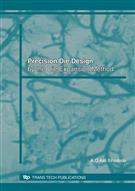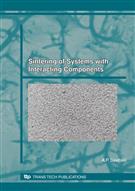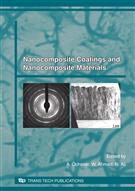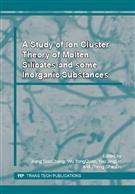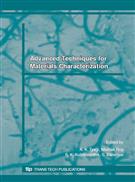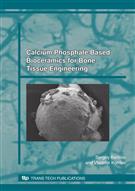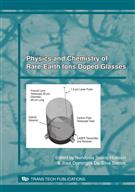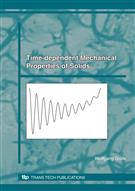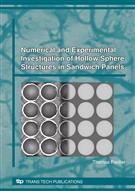Engineering Research
Advanced Engineering Forum
Applied Mechanics and Materials
Engineering Chemistry
Engineering Innovations
Journal of Biomimetics, Biomaterials and Biomedical Engineering
International Journal of Engineering Research in Africa
Materials Science
Advanced Materials Research
Defect and Diffusion Forum
Diffusion Foundations and Materials Applications
Journal of Metastable and Nanocrystalline Materials
Journal of Nano Research
Key Engineering Materials
Materials Science Forum
Nano Hybrids and Composites
Solid State Phenomena
Engineering Series
Advances in Science and Technology
Construction Technologies and Architecture
Engineering Headway
Foundations of Materials Science and Engineering
Volume in the series: 59-60
Authors:
Prof. Akii Okonigbon Akaehomen Ibhadode
Volume is indexed by Thomson Reuters BCI (WoS).
This book presents a new method for the design of the precision dies used in cold-forging, extrusion and drawing processes. The method is based upon die expansion, and attempts to provide a clear-cut theoretical basis for the selection of critical die dimensions for this group of precision dies when the tolerance on product diameter (or thickness) is specified. It also presents a procedure for selecting the minimum-production-cost die from among a set of design alternatives.
This book presents a new method for the design of the precision dies used in cold-forging, extrusion and drawing processes. The method is based upon die expansion, and attempts to provide a clear-cut theoretical basis for the selection of critical die dimensions for this group of precision dies when the tolerance on product diameter (or thickness) is specified. It also presents a procedure for selecting the minimum-production-cost die from among a set of design alternatives.
eBook:
$193.00
Volume in the series: 57-58
Authors:
A.P. Savitskii
Volume is indexed by Thomson Reuters BCI (WoS).
The aim of this publication is to acquaint those readers who are interested in the fundamentals of powder materials sintering, with the latest scientific achievements which are important to its successful practice. The book contains new information, not previously known in the West, as well as offering a totally fresh view of this vital issue. The work discloses to western eyes a new scientific trend in the science of sintering systems with interacting components; a trend of which many experts are unaware. The new approach will considerably enrich and advance investigations into the theory and practice of sintering and aid their further development.
The aim of this publication is to acquaint those readers who are interested in the fundamentals of powder materials sintering, with the latest scientific achievements which are important to its successful practice. The book contains new information, not previously known in the West, as well as offering a totally fresh view of this vital issue. The work discloses to western eyes a new scientific trend in the science of sintering systems with interacting components; a trend of which many experts are unaware. The new approach will considerably enrich and advance investigations into the theory and practice of sintering and aid their further development.
eBook:
$193.00
Volume in the series: 56
Authors:
T. Aizawa
Volume is indexed by Thomson Reuters BCI (WoS).
Since the mid-nineties, magnesium-based alloys and compounds have been revisited in the hope that they will yield light functional materials. In this third wave of research and development of magnesium-based hydrogenstorage and thermoelectric materials, new factors have become important in addition to the improvement of their properties and performance. The move to reduce environmental damage requires the assurance of non-toxicity and energy-saving during manufacture. For example, the use of lead or bismuth additions must be avoided. Furthermore, due to the diminishing sources of antimony, tellurium and rare-earth elements, only metallic and non-metallic elements having a large Clerk number should be used for production. In order to compensate for these restraints, nano-technological innovation is urgently required; not only in optimum material design but also in material processing, manufacturing and device production, in order to achieve significant energy and cost savings.
Since the mid-nineties, magnesium-based alloys and compounds have been revisited in the hope that they will yield light functional materials. In this third wave of research and development of magnesium-based hydrogenstorage and thermoelectric materials, new factors have become important in addition to the improvement of their properties and performance. The move to reduce environmental damage requires the assurance of non-toxicity and energy-saving during manufacture. For example, the use of lead or bismuth additions must be avoided. Furthermore, due to the diminishing sources of antimony, tellurium and rare-earth elements, only metallic and non-metallic elements having a large Clerk number should be used for production. In order to compensate for these restraints, nano-technological innovation is urgently required; not only in optimum material design but also in material processing, manufacturing and device production, in order to achieve significant energy and cost savings.
eBook:
$132.00
Volume in the series: 54-55
Authors:
Prof. Andreas Öchsner, W. Ahmed and N. Ali
Volume is indexed by Thomson Reuters BCI (WoS).
Nanocomposite materials are formed by mixing two or more dissimilar materials at the nanoscale in order to control and develop new and improved structures and properties. The properties of nanocomposites depend not only upon the individual components used but also upon the morphology and the interfacial characteristics. Nanocomposite coatings and materials are among the most exciting and fastest-growing areas of research; with new materials being continually developed which often exhibit novel properties that are absent in the constituent materials. Nanocomposite materials and coatings therefore offer enormous potential for new applications including: aerospace, automotive, electronics, biomedical implants, non-linear optics, mechanically reinforced lightweight materials, sensors, nano-wires, batteries, bioceramics, energy conversion and many others.
Nanocomposite materials are formed by mixing two or more dissimilar materials at the nanoscale in order to control and develop new and improved structures and properties. The properties of nanocomposites depend not only upon the individual components used but also upon the morphology and the interfacial characteristics. Nanocomposite coatings and materials are among the most exciting and fastest-growing areas of research; with new materials being continually developed which often exhibit novel properties that are absent in the constituent materials. Nanocomposite materials and coatings therefore offer enormous potential for new applications including: aerospace, automotive, electronics, biomedical implants, non-linear optics, mechanically reinforced lightweight materials, sensors, nano-wires, batteries, bioceramics, energy conversion and many others.
eBook:
$193.00
Volume in the series: 52-53
Authors:
Jiang GuoChang, Wu YongQuan, You JingLin and Zheng ShaoBo
Volume is indexed by Thomson Reuters BCI (WoS).
The first part of this monograph consists of a discussion of the microstructures of molten silicates and other inorganic substances. It is made up of seven chapters. Chapter 1 considers developments in ion-cluster theory. Chapter 2 introduces experimental approaches to the direct monitoring of a molten sample, such as hightemperature Raman spectroscopes which have successfully recorded Raman spectra from melts at temperatures of 2000K or more. Chapter 3 shows that five types of Si-O tetrahedron are appropriate microstructural units for setting up structural models. Chapter 4 confirms the SiOT model as being the primary ion-cluster theory for the efficient and reliable description of high-temperature Raman spectra. In Chapter 5, the CEMS model is created in order to interconnect microstructures and thermodynamic properties - with no adjustable parameters. Chapter 6 discusses the applicability of ab initio calculations. The Raman spectra of other inorganic compounds are shown in Chapter 7, and the use of Raman spectra to study phase transformations and solid/melt interfaces is also discussed.
The first part of this monograph consists of a discussion of the microstructures of molten silicates and other inorganic substances. It is made up of seven chapters. Chapter 1 considers developments in ion-cluster theory. Chapter 2 introduces experimental approaches to the direct monitoring of a molten sample, such as hightemperature Raman spectroscopes which have successfully recorded Raman spectra from melts at temperatures of 2000K or more. Chapter 3 shows that five types of Si-O tetrahedron are appropriate microstructural units for setting up structural models. Chapter 4 confirms the SiOT model as being the primary ion-cluster theory for the efficient and reliable description of high-temperature Raman spectra. In Chapter 5, the CEMS model is created in order to interconnect microstructures and thermodynamic properties - with no adjustable parameters. Chapter 6 discusses the applicability of ab initio calculations. The Raman spectra of other inorganic compounds are shown in Chapter 7, and the use of Raman spectra to study phase transformations and solid/melt interfaces is also discussed.
eBook:
$193.00
Volume in the series: 49-51
Authors:
A. K. Tyagi, Mainak Roy, S. K. Kulshreshtha and S. Banerjee
Volume is indexed by Thomson Reuters BCI (WoS).
Nowadays, an impressively large number of powerful characterization techniques is being used by physicists, chemists, biologists and engineers in order to solve analytical research problems; especially those related to the investigation of the properties of new materials for advanced applications. Although there are a few available books which deal with such experimental techniques, they are either too exhaustive and cover very few techniques or are too elementary to provide a solid basis for learning to use the characterization technique. Moreover, such books usually over-emphasize the textbook approach: being full of theoretical concepts and mathematical derivations, and omitting the practical instruction required in order to permit newcomers to use the techniques.
Nowadays, an impressively large number of powerful characterization techniques is being used by physicists, chemists, biologists and engineers in order to solve analytical research problems; especially those related to the investigation of the properties of new materials for advanced applications. Although there are a few available books which deal with such experimental techniques, they are either too exhaustive and cover very few techniques or are too elementary to provide a solid basis for learning to use the characterization technique. Moreover, such books usually over-emphasize the textbook approach: being full of theoretical concepts and mathematical derivations, and omitting the practical instruction required in order to permit newcomers to use the techniques.
eBook:
$198.00
Volume in the series: 48
Authors:
Sergey Barinov and Vladimir Komlev
Tissue engineering is a new biotechnology that combines various aspects of medicine, biology and engineering, in order to produce, repair or replace human tissue. It is therefore easy to grasp the potential of these new therapies in helping to improve the quality-of-life of patients suffering from rare diseases. Typically, bone tissue engineering approaches foresee the use of scaffolding material combined with tissue cells. An advanced scaffolding material for tissue engineering must exhibit high quality, reliability, sustainability and cost-effectiveness throughout the individual’s life and provide new advanced levels of medical assistance in therapy and surgery. One particular requirement of bone tissue engineering is that the scaffold should be porous because, in that form, large numbers of cells can be incorporated.
eBook:
$138.00
Volume in the series: 46-47
Authors:
Dr. Sooraj Hussain Nandyala and Prof. José Domingos da Silva Santos
eBook:
$193.00
Volume in the series: 45
Authors:
Wolfgang Gräfe
This treatment of “Time-Dependent Mechanical Properties of Solids” begins with a phenomenological description of the transport of some unspecified entity. It is assumed that the transport is caused by mechanical stresses or temperature fields. This hypothesis is based upon just a few well-established methods such as, for instance, the Zener theory of diffusion and the Inglis equation for stress enhancementof. Using these assumptions, it is possible to deduce formulae for a theoretically based description of several phenomena without referring to any specific process or entity.
eBook:
$138.00
Volume in the series: 44
Authors:
Thomas Fiedler
eBook:
$132.00
